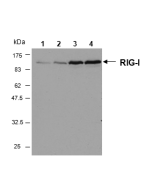Cookie Policy: This site uses cookies to improve your experience. You can find out more about our use of cookies in our Privacy Policy. By continuing to browse this site you agree to our use of cookies.
AdipoGen Life Sciences
anti-RIG-I, mAb (Alme-1) (Biotin)
As low as
530
CHF
CHF 530.00
In stock
Only %1 left
AG-20B-0009B-C100100 µgCHF 530.00

| Product Details | |
|---|---|
| Synonyms | RIG-1; Retinoic Acid-inducible Gene 1 Protein; DEAD-box Protein 58; Probable ATP-dependent RNA Helicase DDX58 |
| Product Type | Monoclonal Antibody |
| Properties | |
| Clone | Alme-1 |
| Isotype | Mouse IgG1 |
| Source/Host | Purified from concentrated hybridoma tissue culture supernatant. |
| Immunogen/Antigen | Recombinant human RIG-I (aa 201-713). |
| Label/Conjugates | Biotin |
| Application |
Immunohistochemistry: (paraffin sections) |
| Crossreactivity |
Human Mouse |
| Specificity |
Recognizes human and mouse RIG-I. |
| Purity | ≥95% (SDS-PAGE) |
| Purity Detail | Protein G-affinity purified. |
| Concentration | 0.5mg/ml |
| Formulation | Liquid. In PBS containing 0.02% sodium azide. |
| Isotype Negative Control | |
| Shipping and Handling | |
| Shipping | BLUE ICE |
| Short Term Storage | +4°C |
| Long Term Storage | -20°C |
| Handling Advice |
After opening, prepare aliquots and store at -20°C. Avoid freeze/thaw cycles. |
| Use/Stability | Stable for at least 1 year after receipt when stored at -20°C. |
| Documents | |
| MSDS |
 Download PDF Download PDF |
| Product Specification Sheet | |
| Datasheet |
 Download PDF Download PDF |
Description
RIG-I and MDA5 are highly conserved helicases involved in the innate immune response to virus. RIG-I is a member of the DEAD-box RNA helicases and is activated by cytoplasmic dsRNA and 5’-ppp RNA produced during the viral replication. The protein is characterized by a N-terminal region with two caspase recruitment domains (CARD) and a C-terminal region harboring potential ATP-dependent RNA helicase activity. RIG-I recruits the CARD adaptor inducing IFN-β (Cardif) in a CARD-CARD-dependent manner resulting in NF-κB and IRF3 activation.
Product References
- The antiviral adaptor proteins Cardif and Trif are processed and inactivated by caspases: M. Rebsamen, et al.; Cell Death Differ. 15, 1804 (2008)
- Phosphorylation-mediated negative regulation of RIG-I antiviral activity: M.U. Gack, et al.; J. Virol. 84, 3220 (2010)
- Incoming RNA Virus Nucleocapsids Containing a 5'-Triphosphorylated Genome Activate RIG-I and Antiviral Signaling: M. Weber, et al.; Cell Host Microbe 13, 336 (2013)
- Lymphocytic choriomeningitis virus differentially affects the virus-induced type I interferon response and mitochondrial apoptosis mediated by RIG-I/MAVS: C. Pythoud, et al.; J. Virol. 89, 6240 (2015)
- A phosphomimetic-based mechanism of dengue virus to antagonize innate immunity: Y.K. Chan & M.U. Gack; Nat. Immunol. 17, 523 (2016)
- Sensing of latent EBV infection through exosomal transfer of 5'pppRNA: S.R. Baglio, et al.; PNAS 113, E587 (2016)
- RNAs Containing Modified Nucleotides Fail To Trigger RIG-I Conformational Changes for Innate Immune Signaling: A. Fiegen Durbin, et al.; MBio 7, e00833 (2016)
- Viral unmasking of cellular 5S rRNA pseudogene transcripts induces RIG-I-mediated immunity: J.J. Chiang, et al.; Nat. Immunol. 19, 53 (2018)
- RIG-I recognizes the 5′ region of dengue and zika virus genomes: M. Chazal, et al.; Cell Rep. 24, 320 (2018)
- The Human Papillomavirus E6 Oncoprotein Targets USP15 and TRIM25 To Suppress RIG-I-Mediated Innate Immune Signaling: C. Chiang, et al.; J. Virol. 92, e01737-17 (2018) [KO Validation]
- Zika virus NS3 mimics a cellular 14-3-3-binding motif to antagonize RIG-I- and MDA5-mediated innate immunity: W. Riedl, et al.; Cell Host Microbe 26, 493 (2019)
- Influenza A virus M2 protein triggers mitochondrial DNA-mediated antiviral immune responses: M. Moriyama, et al.; Nat. Comm. 10, 6424 (2019)
- Attenuation of the Innate Immune Response against Viral Infection Due to ZNF598-Promoted Binding of FAT10 to RIG-I: G. Wang, et al.; Cell Rep. 28, 1961 (2019)






